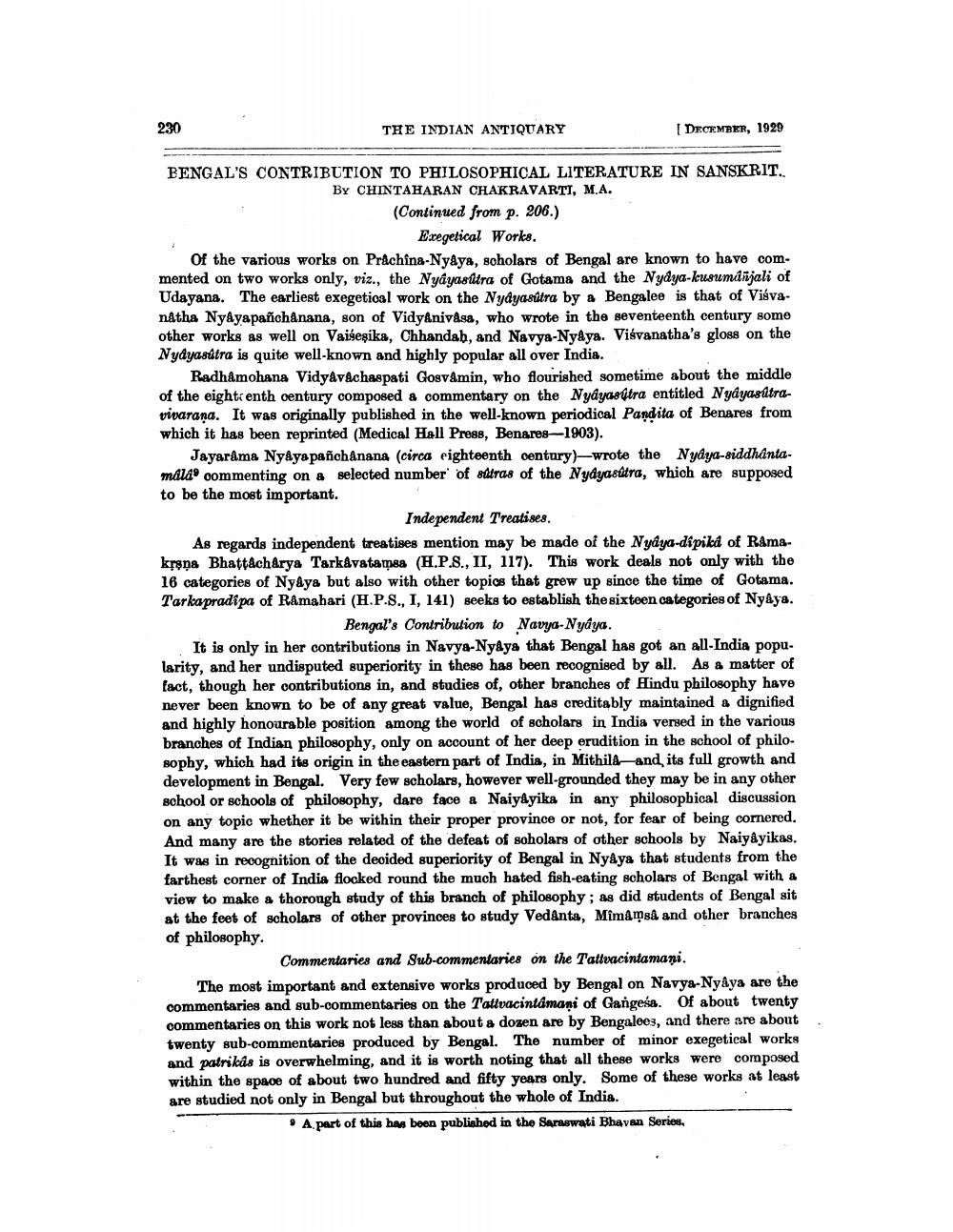________________
230
THE INDIAN ANTIQUARY
DECEMBER, 1929
BENGAL'S CONTRIBUTION TO PHILOSOPHICAL LITERATURE IN SANSKRIT..
BY CHINTAHARAN CHAKRAVARTI, MA.
(Continued from p. 206.)
Exegetical Works. of the various works on Prachina-Ny&ys, scholars of Bengal are known to have commented on two works only, viz., the Nyayasútra of Gotams and the Nydya-kusumuiñjali of Udayana. The earliest exegetical work on the Nydyasútra by a Bengalee is that of Visvanátha Nyâyapanchanana, son of Vidy&nivasa, who wrote in the seventeenth century some other works as well on Vaiseşika, Chhandab, and Navya-NyAya. Visvanatha's gloss on the Nydyasútra is quite well-known and highly popular all over India.
Radhåmohana Vidyavachaspati Gogvåmin, who flourished sometime about the middle of the eighteenth century composed a commentary on the Nyayasútra entitled Nydyasitravivarana. It was originally published in the well-known periodical Pandita of Benares from which it has been reprinted (Medical Hall Press, Benares--1903).
Jayarama Nyâya panoh Anana (circa eighteenth century)-wrote the Nydya-siddhantamala commenting on & selected number of sutras of the Nydyasútra, which are supposed to be the most important.
Independent Treatises. As regards independent treatises mention may be made of the Nydya-dípika of Ramakrana Bhattacharya TarkAvatamaa (H.P.S., II, 117). This work deals not only with the 16 categories of Nyâya but also with other topics that grew up since the time of Gotama. Tarkapradipa of Råmahari (H.P.S., I, 141) seeks to establish the sixteen categories of Ny&ya.
Bengal's Contribution to Navya-Nyaya. It is only in her contributions in Navya-Nyaya that Bengal has got an all-India popularity, and her undisputed superiority in these has been recognised by all. As & matter of fact, though her contributions in, and studies of, other branches of Hindu philosophy have never been known to be of any great value, Bengal has creditably maintained a dignified and highly honourable position among the world of scholars in India versed in the various branches of Indian philosophy, only on account of her deep erudition in the school of philoBophy, which had its origin in the eastern part of India, in Mithila and its full growth and development in Bengal. Very few scholars, however well-grounded they may be in any other school or schools of philosophy, dare face a Naiya yika in any philosophical discussion on any topic whether it be within their proper province or not, for fear of being cornered. And many are the stories related of the defeat of soholars of other schools by Naiyáyikas. It was in recognition of the decided superiority of Bengal in NyAya that students from the farthest corner of India flocked round the much hated fish-eating scholars of Bengal with a view to make a thorough study of this branch of philosophy; as did students of Bengal sit at the feet of scholars of other provinces to study Vedanta, Mimamsa and other branches of philosophy.
Commentaries and Sub-commentaries on the Tattvacintamani. The most important and extensive works produced by Bengal on Navya-Nyâya are the commentaries and sub-commentaries on the Tallvacintamani of Gangesa. Of about twenty commentaries on this work not less than about a dozen are by Bengaloes, and there are about twenty sub-commentaries produced by Bengal. The number of minor exegetical works and patrikás is overwhelming, and it is worth noting that all these works were composed within the space of about two hundred and fifty years only. Some of these works at least are studied not only in Bengal but throughout the whole of India.
A part of this has been published in the Saraswati Bhavan Series,




